Forty Years of Lunar Lander
In 1969, an Apollo-crazy high school student wrote one of the most influential computer games of all time.By Benj Edwards | Sunday, July 19, 2009 at 11:54 pm
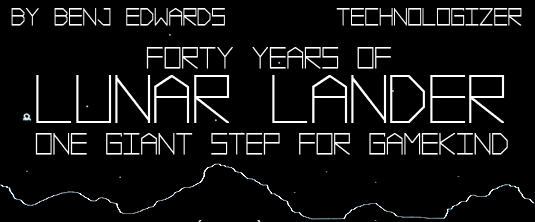
Lunar Lander games abound on every platform. Along with Tetris and Pac-Man, the game–in which your mission is to safely maneuver your lunar module onto the moon’s surface–is one of the most widely cloned computer games of all time. But did you know that game players began touching down on the moon in Lunar Lander just months after Apollo 11 astronauts Neil Armstrong and Buzz Aldrin did so on July 20th, 1969?
 Today’s versions of Lunar Lander are easily taken for granted; they’re generally regarded as dinky games you can get for free–“Who would pay for that?”
Today’s versions of Lunar Lander are easily taken for granted; they’re generally regarded as dinky games you can get for free–“Who would pay for that?”
But the mother of all realistic space simulations wasn’t always perceived that way. In 1969, it was, in its own way, a sophisticated, ambitious piece of digital entertainment. And during the BASIC era of the 1970s and 80s, many programmers cut their teeth by attempting to program their own version of Lunar Lander. David Ahl, founder of Creative Computing magazine, called it “by far and away the single most popular computer game” in 1978 (and he was only talking about the text version!). Indeed, Lunar Lander was one of the early computer games that helped define computer games.
The Eagle Lands
YOU ARE LANDING ON THE MOON AND HAVE TAKEN OVER MANUAL
CONTROL 500 FEET ABOVE A GOOD LANDING SPOT. YOU HAVE A
DOWNWARD VELOCITY OF 50 FT/SEC. 120 UNITS OF FUEL REMAIN.
Among the millions who watched the Apollo 11 landing was a 17 year old Massachusetts high school student named Jim Storer. In the fall of 1969, around the time of the Apollo 12 launch, Storer took his inspiration to class with him. There, he programmed a simple text-based simulation of humanity’s greatest technological achievement on his school’s Digital Equipment Corp. PDP-8 minicomputer system.
“Lexington High School had a PDP-8,” Storer recalls. “It had 8 Teletypes, a small hard drive, and 12KB of main memory, where 8KB was used by the system and 4KB time shared by the users.”
Storer wrote his new program, “Lunar Landing Game,” in FOCAL, a programming language for the PDP-8 that was similar in some ways to BASIC (both were introductory languages known for their ease of use). His simulation was simple, yet powerful: underneath lay a realistic set of equations Storer believes his father may have taught him.
Lunar Landing Game’s gameplay consisted of a turn-based question and answer session, asking the user for the rocket fuel burn rate at each turn, which the user would then enter as a number from 0 to 200. The constraints against you were simple:
HERE ARE THE RULES THAT GOVERN YOUR SPACE VEHICLE:
(1) AFTER EACH SECOND, THE HEIGHT, VELOCITY, AND REMAINING FUEL WILL BE REPORTED.(2) AFTER THE REPORT, A ‘?’ WILL BE TYPED. ENTER THE
NUMBER OF UNITS OF FUEL YOU WISH TO BURN DURING THE
NEXT SECOND. EACH UNIT OF FUEL WILL SLOW YOUR DESCENT
BY 1 FT/SEC.(3) THE MAXIMUM THRUST OF YOUR ENGINE IS 30 FT/SEC/SEC OR
30 UNITS OF FUEL PER SECOND.(4) WHEN YOU CONTACT THE LUNAR SURFACE, YOUR DESCENT ENGINE
WILL AUTOMATICALLY CUT OFF AND YOU WILL BE GIVEN A
REPORT OF YOUR LANDING SPEED AND REMAINING FUEL.(5) IF YOU RUN OUT OF FUEL, THE ‘?’ WILL NO LONGER APPEAR,
BUT YOUR SECOND BY SECOND REPORT WILL CONTINUE UNTIL
YOU CONTACT THE LUNAR SURFACE.
Along the way, Jim Storer created one of the earliest computer games–one of a handful of text-based PDP-8 games of the 1960s, and one of the first computer simulation games ever. In less than 50 lines of code, Storer captured the imaginations of an entire generation of programmers with a gripping space drama composed of nothing more than simple text statements.
Storer submitted his game to PDP-8 maker DEC, which was always looking for innovative and interesting uses of its computers. The programs were usually distributed for free or used as demonstrations to potential clients, serving as a powerful marketing tool. At DEC, an employee named David H. Ahl translated Storer’s Lunar Lander into the BASIC language, which soon overtook FOCAL as the most popular introduction to programming. From there, both the FOCAL and BASIC versions of Storer’s simulation spread to other PDP-8 users through DEC’s EDU newsletter and through distribution by DEC’s Education Product Group.
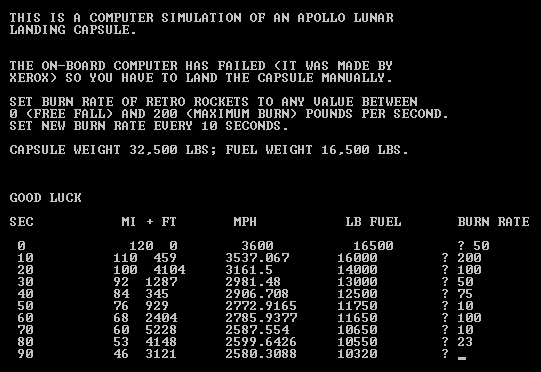
After that, Storer forgot about the game. Life went on. He never sold it, and never followed the progress or influence of its imitators as they echoed down through the years. “After leaving high school I never thought about the game again,” says Storer. “Until about a couple of months ago when someone e-mailed me about this, I was completely unaware of any Lunar Lander game other than the one I wrote in high school.”
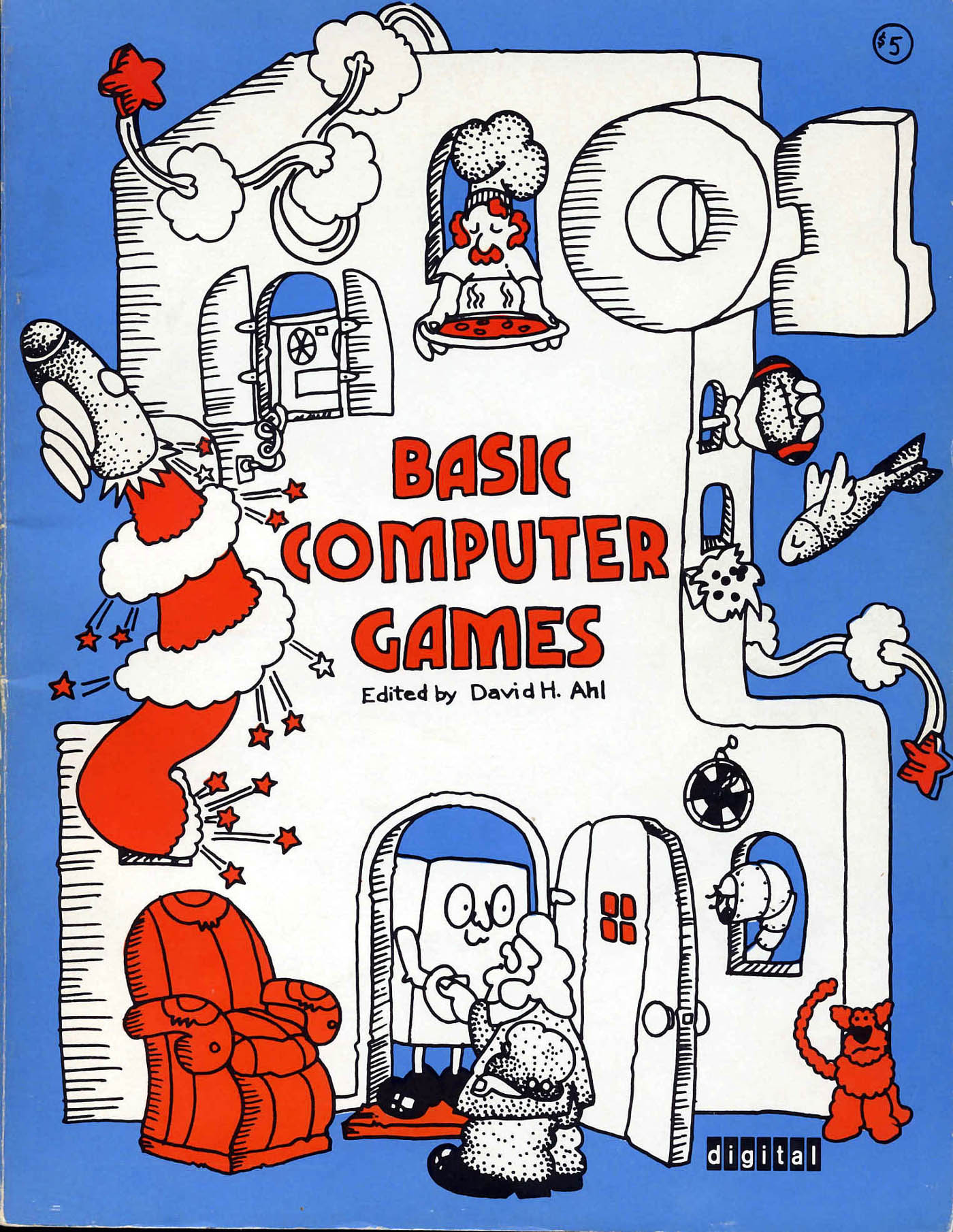 But Storer’s computer experiences in high school shaped the rest of his career: “I became interested in computer science as a result of taking that computer class and doing programming on the PDP-8.” Storer later studied computer science as an undergraduate at Cornell University and then received his Ph.D. in Computer Science at Princeton University. He is now a professor of computer science at Brandeis University.
But Storer’s computer experiences in high school shaped the rest of his career: “I became interested in computer science as a result of taking that computer class and doing programming on the PDP-8.” Storer later studied computer science as an undergraduate at Cornell University and then received his Ph.D. in Computer Science at Princeton University. He is now a professor of computer science at Brandeis University.
In 1973, DEC published a book edited by Ahl called “101 BASIC Computer Games” that included both Storer’s version of Lunar Lander and two others that had been inspired by Storer’s program. In 1978, Ahl revamped the book with a focus on home microcomputers that were common at the time, and it sold over a million copies. Thanks to Ahl’s book, Lunar Lander’s status as one of the classics of early computer gaming was assured.
Lunar Lander Gets Graphical
DEC consultant Jack Burness had long been a fan of America’s race to the moon. He recalls with great clarity the excitement of the period: “The space program was an incredibly big project then. More than a project, it was a national embracing of the future.”
Inspired by a co-worker who attended the launch of Apollo 16, Burness pestered his local senator for passes to see the launch of the final Apollo mission, Apollo 17, in December 1972. “A bunch of my friends went with me to see it,” recalls Burness. “It was the last launch and was at night–an overwhelming powerfully experience.”
That experience simmered in the back of his mind for the next few months, and it proved influential when DEC needed a software demo for its new GT40 terminal.
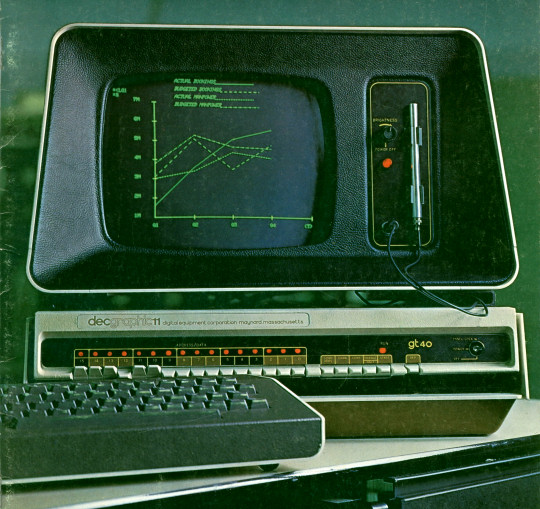
The DEC GT40 was a graphical computer terminal–unusual for its time, since it used a vector CRT display. One electron gun directly drew geometric shapes on the screen, providing a potent way to generate sharp, high-resolution computer graphics with the limited computing power available at the time. Conventional bitmapped raster displays (like those on conventional TV video games) draw the screen progressively from top to bottom, one row at a time, and required vastly more memory to compose a detailed on-screen image.
“I actually had quit Digital the previous spring and moved to Cambridge to consult for Draper Labs,” says Burness. “For some now long-forgotten reason I was back consulting to DEC that winter.”
Burness won the contract from DEC and began developing a lunar landing simulation for the terminal in early 1973. He programmed the game in PDP-11 assembly language, as the GT40 contained within it a PDP-11 CPU, essentially making it a standalone computer system. “But the graphics processor had its own instruction set,” adds Burness, “and I programmed that in assembly as well.”
To make a realistic simulation, Burness went straight to MIT, which had co-designed the real NASA lunar module. “It only took a few hours of perusing around to dig up enough information (weight, fuel burn rate, etc.) to write the program,” he says.

As for inspiration, Burness doesn’t recall seeing Storer’s exact version of the “Lunar Landing Game,” but by 1973, clones of the Storer’s text-based simulation were already commonplace. Still, Burness’ version had one very important difference from those that had come before it: it had graphics. His game, which he called “Moonlander,” took advantage of the GT40’s vector display to draw a moonscape as seen from the side.
Gameplay was simple, but challenging: The player wielded the GT40’s integrated light pen and carefully guided the lunar module’s descent by touching areas of the screen that controlled thrust. The player attempted to land via thrusting the lunar module’s rockets in real time while avoiding too fast an entry, or too steep an angle. With Burness’ innovations, the modern action-based Lunar Lander we all know today was born.
“Start of the project to completion was ten days. That’s it,” says Burness. “When you only have a small amount of computer memory, choices become simpler.”
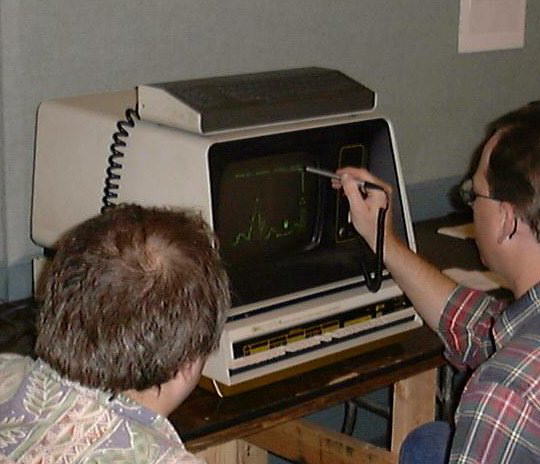 Moonlander proved an immediate hit with DEC and other users of the GT40. From there, it spread wherever GT40s were in use, and influenced a sizable audience as one of the first graphical computer games.
Moonlander proved an immediate hit with DEC and other users of the GT40. From there, it spread wherever GT40s were in use, and influenced a sizable audience as one of the first graphical computer games.
Years later, a co-worker told Burness that the reason he got into programming was because he had played Moonlander as a teenager. “I think it’s kind of neat the way you do something and it can have a rippling effect,” he says.
Burness never made any money on Moonlander, but his experience with the GT40 solidified his interest in computer graphics. He spent the next 26 years of his career bouncing between various computer graphics companies, and still consults for technology startups today.
Landing at the Arcade
Before the decade was out, one of Burness’ biggest fans brought Lunar Lander out of the halls of mainframe academia and into the commercial realm, further widening its audience: Atari.
By 1979, video game pioneer Atari had been working on bringing vector technology to its arcade games for two years. They were inspired by Cinematronics’ 1977 Space Wars arcade game to develop vector hardware of their own. Rick Moncrief led the project.
“Before there was a game, we had to make a vector graphic system,” recalls Howard Delman, an Atari engineer who co-created many Atari arcade games in the 1970s. “Rick and I worked on that. When we were done, we said ‘What should we do with it?’ I said, ‘How about we make Lunar Lander?’
With the help of Rich Moore on software, the two created Atari’s first commercial arcade game with vector graphics titled, unsurprisingly, “Lunar Lander.”
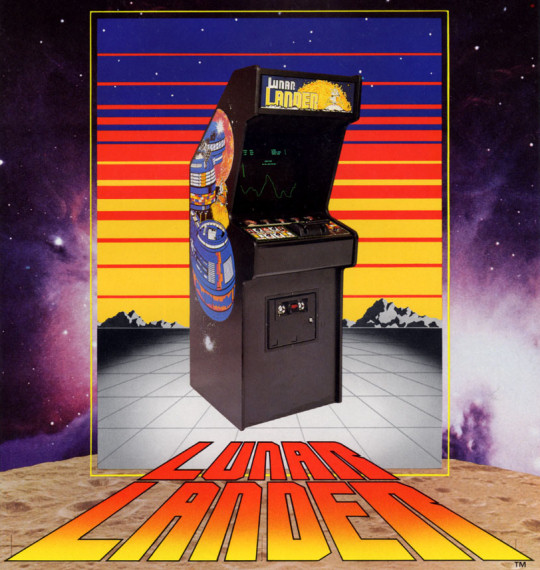
As for Delman’s inspiration, he says he saw a graphical Lunar Lander game–likely Burness’ Moonlander–long before development on Lunar Lander began: “I recall going over to [NASA’s] Ames research center–some Atari folks and I had a tour there–and they showed us a Lunar Lander game running on some machine.” But he doesn’t recall the specifics of the occasion.
Atari’s Lunar Lander was very similar to Burness’ version, except that players controlled the lander with a thruster lever and two rotate buttons. Of course, to make a good arcade video game, Delman had to forgo the hardcore simulation aspect of the computer version and make it fun and simple for anyone to walk up and play. “Not everyone is trained to land a spacecraft on the moon,” he says.
The game included four play modes of varying difficulty — “One is a realistic mode like a real spaceship, and nobody could land that,” says Delman, chuckling. “But the mode it defaults to is very simple. There’s friction on your ship, and the ship only rotates when you touch the controls. We did all these things to make it easier to play.”
Then there was a special button that Delman calls the “save your ass” button: “If you’re out of control, you could hit that and it would straighten out the lander, give you full thrust and try to stop you. It cost you a lot of fuel, but if all hope was lost, you could hit it.”
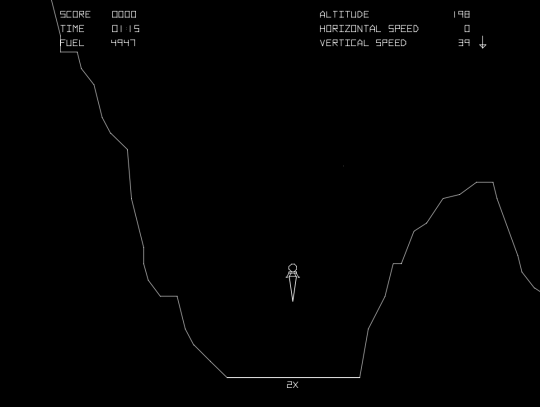
Atari released Lunar Lander in August, 1979–just after the tenth Anniversary of the Apollo 11 moon landing . Strangely, it appears that Atari didn’t capitalize on the anniversary while marketing their new machine. It’s forgivable, because Atari’s attention was quickly diverted when another vector game’s sales started taking off like a rocket ship.
Atari’s Asteroids, also released in 1979, used the same vector hardware as Lunar Lander. Asteroids became so successful that Atari soon stopped production of Lunar Lander to start building Asteroids machines. “The first 300 Asteroids games went out with Lunar Lander artwork on the side,” recalls Delman. Still, Atari sold about 4700 Lunar Lander machines, which Delman says was a “good run” at the time. It’s likely that Atari would have sold more Lunar Lander units if Asteroids hadn’t stolen the spotlight.
Overall, it was this version of Lunar Lander by Atari that received the widest audience, and soon hobby programmers of the early software revolution began coding their own versions of the game for home computers of the time: the TRS-80, Apple II, Commodore PET, Atari 800, and other. The trend continues on nearly every computer platform released.
To this day, neither Storer or Burness have played Atari’s arcade version of their game, and neither one received any financial compensation from Atari for borrowing their idea. Burness doesn’t seem too upset with the prospect. He seems satisfied in knowing he got there first: “A co-worker told me that my Lunar Lander was actually used as an example of prior art to stop Atari from having a patent on an entire class of computer games.”
After that, Lunar Lander was free to be cloned and re-cloned a million ways, ensuring that its legacy will live on for generations beyond those who created it.
Notable Versions of Lunar Lander Through the Years
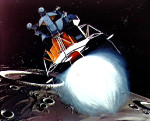 The following list isn’t comprehensive–we would be here for weeks if I tried to account forevery version of Lunar Lander ever made. Instead, we’ll focus on some notable versions released through the years. You can even play some of them online.
The following list isn’t comprehensive–we would be here for weeks if I tried to account forevery version of Lunar Lander ever made. Instead, we’ll focus on some notable versions released through the years. You can even play some of them online.
So Godspeed, virtual astronauts. May the moon’s grip be gentle on your ships.
Lunar Landing Game (1969)
(PDP-8, by Jim Storer)
It’s amazing to think that while men were landing on the moon for the first time, some people were back on Earth playing computer games. This is one of them.
Windows and Linux users can easily play Lunar Landing Game with Vintage BASIC by Lyle Kopnicky. Download the game here.

Rocket (circa 1971)
(PDP-8, by Eric Peters)
Rocket introduced a primitive graphical display that utilized a single asterisk to display altitude. It was still text based.
Windows and Linux users can easily play Rocket with Vintage BASIC. Download the game here.
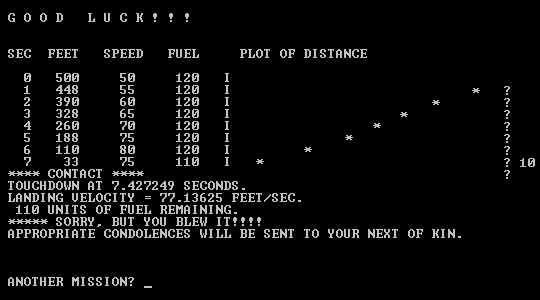
LEM (circa 1971)
(DEC PDP-8, by William Labaree II)
Labaree’s version is the most complex of the text-based landing simulators. It even offers to display readouts in either English or Metric units.
Windows and Linux users can easily play LEM with Vintage BASIC. Download the game here.
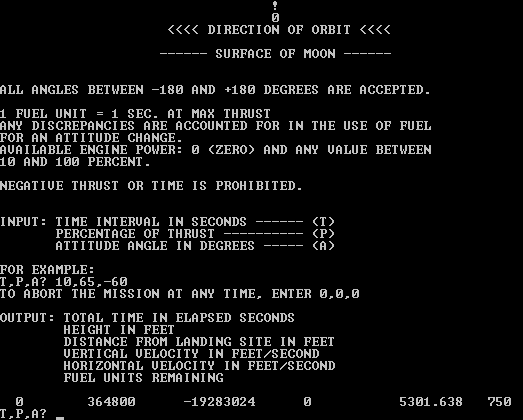
Moonlander (1973)
(DEC GT40, by Jack Burness)
The original graphical Lunar Lander game. Feel free to peruse the original source code, if you’re so inclined.

Lunar Lander (1979)
(Arcade, by Rich Moore and Howard Delman for Atari)
Atari’s first arcade game with vector graphics. It spawned most of the clones you see today. Play it online at Atari’s website (requires Java).

Tranquility Base (1980)
(Apple II, by Bill Budge)
x`Before he found fame at Electronic Arts for his Pinball Constuction Set, Bill Budge coded this very accurate clone of Atari’s Lunar Lander on the Apple II. It even simulates vector graphics.
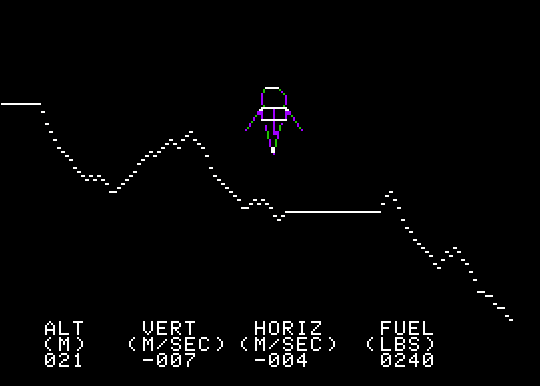
Jupiter Lander (1982)
(VIC-20, by Hitoshi Suzuki for HAL Laboratory)
While this game was also released on the Commodore 64, purists consider Suzuki’s VIC-20 version to be superior.
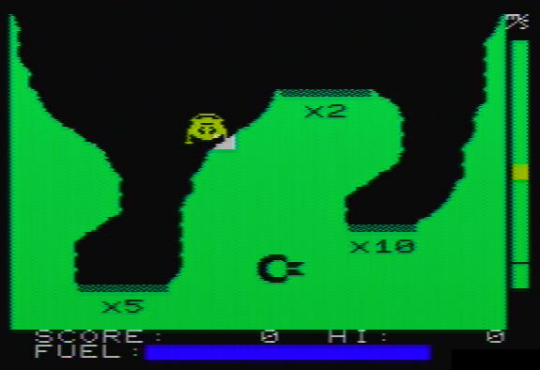
Rocket Lander (1982)
(IBM PC, by IBM)
Home of the Underdogs describes this as a “a good–but very rare–conversion of the hit arcade game Lunar Lander.”
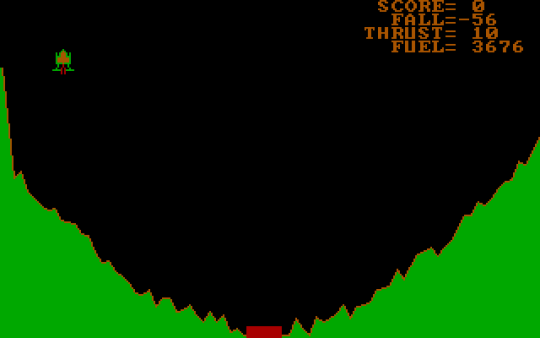
Lander (1990)
(Windows 3.x, by George Moromisato)
This is the version of Lunar Lander the author recalls most fondly. You can get it here, but it needs Windows 3.1 to run properly.
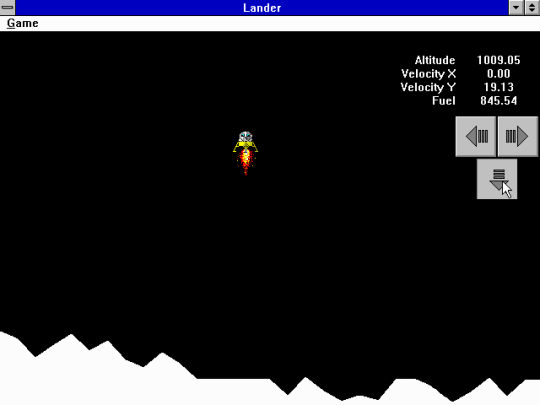
Lunar Lander (1990)
(Game Boy, by Pack-In-Video Co., Ltd.)
Only released in Japan, this Nintendo Game Boy version of Lunar Lander is a rare treat for westerners–if you can find it.
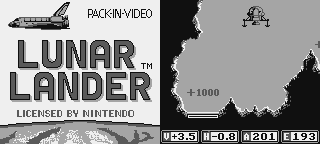
Lander (1999)
(Windows, by Psygnosis Limited)
An interesting modern 3D verision of the classic, unique because of its commercial status.
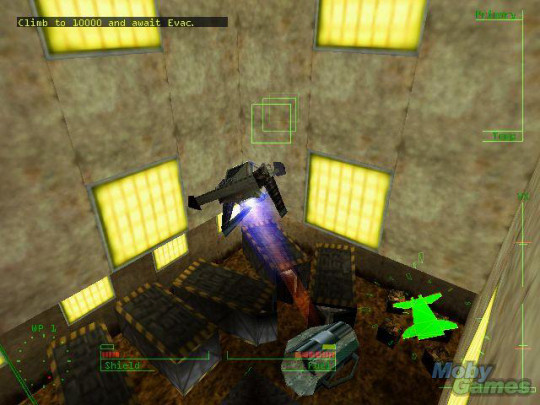
Lunar Lander (2007)
(Android, by Android Open Source Project)
Lunar Lander is a sample game for Android developers created and distributed by the makers of the Android operating system. It shows that Lunar Lander is still relevant as a demo game for beginning programmers, even today.
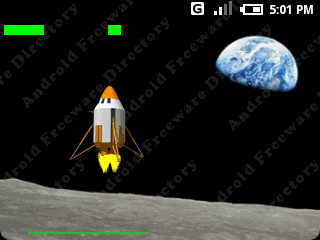
Jupiter Lander (2008)
(Mobile, by Eidos)
Last year, Eidos recreated the Commodore classic (mentioned above) for mobile phones.
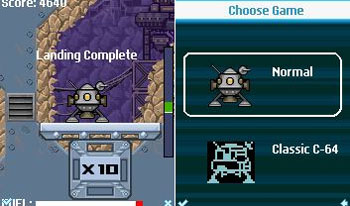
Lunar Module 3D (2009)
(iPhone, by Jason Pastewski and Jim Covert)
The iPhone App Store hosts over ten different variations on Burness’ classic Lunar Lander game. One of the most notable is this 3D version, Lunar Module 3D.
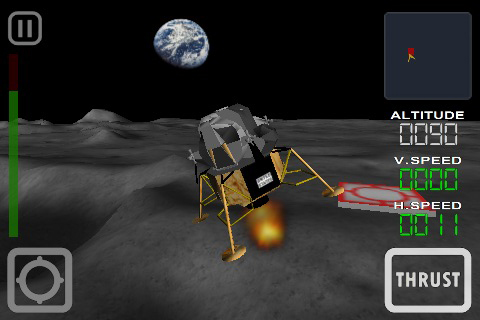
Lunar Lander (199x-present)
(Flash, by everybody)
Lunar Lander has lived on as a favorite game to create among Flash developers. You can find literally dozens of Flash versions of the game to play online through your web browser. Here’s a good version that mimics Atari’s Lunar Lander arcade game.
Even the Science Channel has a Flash-based Lunar Lander game on its website as part of its Apollo 11 40th anniversary celebration.
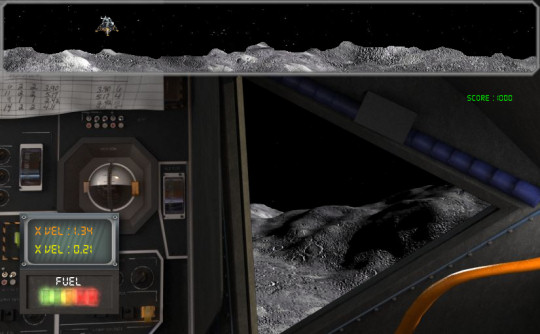
Will Lunar Lander persist for another 40 years? Probably so. It has classic game mechanics that will always be timeless. But personally, I hope that we’ll be playing “Mars Lander” by then.
49 Comments
Read more:
35 Comments For This Post
14 Trackbacks For This Post
-
World’s Oldest Time-Waster? Lunar Lander | Social Nibble Says:
July 20th, 2009 at 2:30 pm[…] beauty contests, and it has a pretty weak storyline unless you have a magnificent imagination, but Lunar Lander may well be one of the oldest time-wasters in […]
-
Top Posts « WordPress.com Says:
July 20th, 2009 at 5:08 pm[…] Forty Years of Lunar Lander Lunar Lander games abound on every platform. Along with Tetris and Pac-Man, the game–in which your mission is to […] […]
-
World’s Oldest Time-Waster? Lunar Lander | DodaPedia Says:
July 21st, 2009 at 9:38 pm[…] beauty contests, and it has a pretty weak storyline unless you have a magnificent imagination, but Lunar Lander may well be one of the oldest time-wasters in […]
-
40th anniversary of the moon landing | The Historical Webber Says:
July 22nd, 2009 at 1:29 pm[…] from space computers to space computer games, the Technologizer has a great piece about a well loved space game, Lunar Lander. This game started out as a […]
-
Aaron’s blah, er, Blog » Remembering Apollo 11 Says:
July 24th, 2009 at 4:12 am[…] for the nerds: Forty Years of Lunar Lander How They Built it: The Software of Apollo 11 How powerful was the Apollo 11 computer? Apollo […]
-
Računalniški muzej » 40 let Lunar Lander-ja Says:
August 13th, 2009 at 10:06 am[…] Skoraj nemogoče je bilo v zadnjem mesecu prezreti evforično in medijsko izredno dobro pokrito praznovanje obletnice prvega človeškega pristanka na luni – Apollo 11. Ravno pod vplivom Apollo misij je najstnik Jim Storer sprogramiral eno izmed prvih računalniških iger – Lunar Lander v jeziku FOCAL. Jezik POCAL je bil napisan za Digitalove PDP-8 računalnike. Malo obširnejši članek na to temo: https://www.technologizer.com/2009/07/19/lunar-lander/. […]
-
Forty Years of Lunar Lander | Mr. Walker's Class Web Says:
September 5th, 2009 at 12:22 pm[…] Forty Years of Lunar Lander Forty Years of Lunar Lander […]
-
The First Great Computer Game -> Lunar Lander | Mr. Walker's Class Web Says:
September 5th, 2009 at 1:19 pm[…] The First Great Computer Game -> Lunar Lander Forty Years of Lunar Lander […]
-
Preview of ‘Lander Hero’ – A Charming Upcoming iPad Cave-Flyer | Touchfresh apps Says:
July 16th, 2011 at 3:49 pm[…] simple proposition there — it's just gravity and you. Lunar Lander, which got its start back in 1969, kicked off the cave-flyer genre that boasts many great games under its banner. iOS developer […]
-
Preview of 'Lander Hero' – A Charming Upcoming iPad Cave-Flyer | Spil og games Nyheder Says:
July 16th, 2011 at 5:06 pm[…] simple proposition there — it's just gravity and you. Lunar Lander, which got its start back in 1969, kicked off the cave-flyer genre that boasts many great games under its banner. iOS developer […]
-
Preview of ‘Lander Hero’ – A Charming Upcoming iPad Cave-Flyer – JailBake Says:
July 16th, 2011 at 5:09 pm[…] the simple proposition there — it’s just gravity and you. Lunar Lander, which got its start back in 1969, kicked off the cave-flyer genre that boasts many great games under its banner. iOS developer […]
-
Preview of ‘Lander Hero’ – A Charming Upcoming iPad Cave-Flyer | TouchArcade.ru Says:
July 16th, 2011 at 5:15 pm[…] simple proposition there — it's just gravity and you. Lunar Lander, which got its start back in 1969, kicked off the cave-flyer genre that boasts many great games under its banner. iOS developer […]
-
Preview of ‘Lander Hero’ – A Charming Upcoming iPad Cave-Flyer – Mudojuegos Says:
July 16th, 2011 at 6:36 pm[…] the simple proposition there — it’s just gravity and you. Lunar Lander, which got its start back in 1969, kicked off the cave-flyer genre that boasts many great games under its banner. iOS developer […]
-
Preview of ‘Lander Hero’ – A Charming Upcoming iPad Cave-Flyer | RemoveWAT SP1 Says:
July 16th, 2011 at 8:08 pm[…] the simple proposition there — it’s just gravity and you. Lunar Lander, which got its start back in 1969, kicked off the cave-flyer genre that boasts many great games under its banner. iOS developer […]













July 20th, 2009 at 12:46 am
Hi there and thanks for the mention! A really interesting article, I never realised the game had a life before the arcade game.
I’ve just finished a 3D Lunar Lander Flash game just in time for the 40th anniversary : http://www.sebleedelisle.com/?p=473
cheers!
Seb
July 20th, 2009 at 6:00 am
I wrote a DSL in the Scala programming language that implements a dialect of BASIC which I then used to write a textual Lunar Lander game. 🙂
http://blog.fogus.me/2009/03/26/baysick-a-scala-dsl-implementing-basic/
-m
July 20th, 2009 at 8:08 am
I went to work for DEC in 1976 and got to play Lunar Lander on a machine in the Mill. I always crashed.
If you landed successfully there was a McDonalds on the Moon.
July 20th, 2009 at 8:16 am
@Dave Barnes
there was a McDonalds on the Moon.
If you landed near it, an astronaut exited the LEM and visited it.
Played it at Westfield in 1976/7 and crashed, too. The tech who “owned” the system showed me the McDonalds, and helped me acquire enough scrap parts to build a VT05 to use for grad school
July 20th, 2009 at 8:37 am
I used to play the GT40 version and there was a McDonalds somewhere on the lunar surface. If you landed close enough a little guy would walk to the arches and order two big macs and a cheeseburger to go. (Not 100% sure about the order!).
R.
July 20th, 2009 at 8:51 am
Hp-25 calculator had a simple version
49 programmable steps
circa 1975
http://www.hpmuseum.org/software/25moonld.htm
March 1st, 2011 at 5:41 am
Hey, thkx, Ralph. I'm writing an academic paper about my Second Life lander simulator inspired in that version I used to play on my old HP25 and I needed that reference. You may have spared me a few hours of googling.
July 20th, 2009 at 9:09 am
I played Lunar Lander on 12/24/1967, on a GE timesharing system (ASR33 teletype, 110 baud acoustic coupler modem). I was a fourteen-year-old and thought I was going to be a chemical engineer. My dad called from the office and said that computer time that day (normally $50/hour) was free and I should come down and play some games. After a few games of Lunar Lander and a football simulator I asked him how it worked, and he said “just type LIST”. The rest, as they say, is history. That day is etched in my memory, and is the day I decided to write software for a living, which I’ve been doing ever since. [The system used Dartmouth BASIC and I recall the Lunar Lander program was only a few hundred lines of code, of which over half was text describing the game.]
July 20th, 2009 at 9:29 am
Here’s a nice implementation.
http://www.lushprojects.com/lunarlander/
It’s with some equally fine exhibits at Southwold pier
http://www.underthepier.com/06_new.htm
July 20th, 2009 at 10:04 am
@Jim: HP-25, eh? I wrote a version for the TI-59 a couple of years after that. Kept it on one of those little whizz back’n’forth memory cards.
Been quite a while since I thought of that.
July 20th, 2009 at 11:03 am
I was at Univ of Miami (FL) in 1970 when I played this game on Dr. Earl Winer’s Lab 8 computer (Industrial Engineering Dept). It was a hybrid PDP-8 and analog machine which used DEC Tape, random access tape, for bulk storage. It had a vector graphic CRT (not TV raster) display. You controlled the LEM using the toggle switches on the PDP-8 face. I believe it might have been written at MIT.
If you landed sucessfully (horizontal and vertical velocity within tolerance and on flat surface), Armstrong emerged, planted a flag, and said One small step for man, one giant leap for mankind.” If you found the MacDonalds (complete with golden arches), he went into the the restaurant and ordered (I think) “a Big Mac to Go”. It was the first computer game I ever played, followed by the Colossal Cave on a PDP-11 and Pong.
Very cool for the time!
Bill Marshak
July 20th, 2009 at 11:33 am
Austin Meyers has a mars lander already built into X-Plane. He also talks about the physics of flight on mars here..
http://www.x-plane.com/mars.html
July 20th, 2009 at 12:29 pm
I developed a character graphics-based version for USCD Pascal in the early 80s at the University of Rochester.
July 20th, 2009 at 12:36 pm
Man I remember playing that game. Back then it was so cool.
July 20th, 2009 at 1:58 pm
Played it on a GE TSS-8 (PDP-8 time sharing system) in 1974 at high school in Pittsfield, MA. There was a version that would report crater size if you crashed.
July 20th, 2009 at 2:58 pm
I didn’t see this fine sim mentioned, if you have a windows machine you are in for a treat.
http://eaglelander3d.com/
July 20th, 2009 at 6:08 pm
What!? No mention of Gravitar!?
http://en.wikipedia.org/wiki/Gravitar
It was kind of a Lunar Lander + Asteroids hybrid. I never could get past the first level, but I loved that game for some reason.
July 20th, 2009 at 7:25 pm
Oi! Tosspots! You’ve missed out an entire generation of these games between ’82 and ’90! Have you ever heard of 8-bit Thrust? Firebird released awful versions of this for C64, ZXSpec and AMX, none of which compared to the 16 bit mastery that was Oids. A fine retrospective on the early history, but there’s a whole generation missing here…
July 20th, 2009 at 8:22 pm
I wrote a Lunar Lander years ago, for the TRS-80 Model III, in BASIC. I’ve had a similar game in the back of my mind, where the player would land on other planets, and in the case of the gas and ice giants, drop a probe into the atmosphere or jettison a satellite. If you got too far into the atmosphere, you’d be crushed. I may still write it one day; maybe for the Dreamcast, as a goof.
July 21st, 2009 at 7:40 am
This prompted me to hunt for a game for IBM that I absolutely loved: “Lunar Module”. I couldn’t find it unfortunately.
You had to take off and land on a vector-based 2D moon surface, killing evil turrets that tried to shoot you down with bullets. It included a level editor, my favorite level was humongous and included some very steep drops. It had unlimited fuel and ammo so maybe it’s not a strict descendant. Must have been from around 1990.
Ah the memories…
July 21st, 2009 at 7:43 am
hey there
awesome write up
A really interesting article
keep penning more
be well
TD
http://techdivine.com/tdblog
July 21st, 2009 at 12:09 pm
I remember a fantastic Lunar Lander simulator running on Control Data 6000 series mainframes around 1970 (one of the most powerful computer systems of the time [http://en.wikipedia.org/wiki/CDC_6000_series]) at Purdue.
The operator’s console, consisting of two vector CRT displays was the interface. One display would be a view port out of the lander show a star-field and the moon; the other display was an instrument panel, all running in real time. Control was via assigned keyboard keys for fuel flow, thrusters, etc. I can’t tell you the number of hours “invested” in honing our skills of a very realistic, demanding program during non-production hours.
July 22nd, 2009 at 4:39 am
My favorite adaptation for Windows is Gravity Well: http://www.plbm.com/gravwell.htm – analog thrust, classic graphics, progressively tough gravity.
July 24th, 2009 at 2:10 pm
I wrote a Lunar Lander graphics program for the Sharp PC1500 computer.
I used the built-in BASIC and a bit of 6502C assembler to do the graphics. At first it was just a dot going left to right. As you got closer to the landing site, you turned the thin but wide display on its side to represent landing.
All in 4K bytes…cor!
Ahh we had so much fun in the 1980s.
🙂
October 14th, 2009 at 1:04 pm
I still have a TTY printout of the source code as well as an instance of playing the game from 1980.
November 9th, 2009 at 10:52 pm
The late 60s origin must be wrong. I played LL on a 1957 text-only vacuum tube and paper tape computer in 1964/65 period. Game had to have been well known (even public domain) by then, did require a dedicated or non-batch (that is interactive) environment; I played it on a machine with no operating system, just a floating point interpreter (a bit like a cross between assembler and BASIC); do not recall whether LL game ran under FP interpreter or was stand-alone. Game printed out a line at a time as you descended to the moon and adjusted your burn rate – looked pretty much like the BASIC run on the Atari listing under wikipedia. My guess LL dates from 1958 or perhaps 1960. Can anyone provide an older example ?
July 2nd, 2010 at 3:36 am
What is the name of the Space Lander type game that also has Space Invader shapes attacking you? You had to land in about 3 places and also go up as well. It's such a long time ago!
July 11th, 2010 at 2:51 pm
It included a level editor, my favorite level was humongous and included some very steep drops. Feels Good.
August 2nd, 2010 at 12:08 pm
You've forgotten a very very weird occurrence of that game :
In the real Sega Pinball game Apollo XIII released in 1995, inspired by the motion picture, there was, outside the fabulous 13-ball multiball mode, a moon landing video mode…
Smile!
HB
September 9th, 2010 at 1:50 pm
Thanks for posting these Adrian
Here's a nice implementation.
http://www.lushprojects.com/lunarlander/
It's with some equally fine exhibits at Southwold pier
http://www.underthepier.com/06_new.htm
December 10th, 2010 at 1:21 am
That day is etched in my memory, and is the day I decided to write software for a living, which I've been doing ever sincet was kind of a Lunar Lander + Asteroids hybrid. I never could get past the first level, but I loved that game for some reason. i
May 8th, 2011 at 4:42 pm
i have a taito lunar rescue. cabinet machine. 1979. like to no more about it.
May 8th, 2011 at 7:53 pm
I HAVE A TAITO 1979 LUNAR RESCUE. COCKTAIL MACHINE. I WOULD LIKE TO NO MORE ABOUT IT. I LIVE IN THE UK. MY NUMBER IS 07932836990. MY NAME IS ANDY
May 9th, 2011 at 11:13 am
i have a TAITO LUNAR RESCUE 1979 COCKTAIL MACHINE. LIKE TO NO MORE ABOUT IT. U CAN CALL ME ON 07932836990
October 23rd, 2011 at 4:32 pm
Great Article, perhaps some if you guys might like to check out the game I am developing called Lunar Flight. http://www.shovsoft.com/lunarflight